
What Could Netherite Be in Real Life? A Deep Dive into Its Possi
Started by Admin
Introduction
Minecraft’s Netherite is one of the most powerful and durable materials in the game, surpassing even diamond in strength. It was introduced in the 1.16 Nether Update, and since then, players have been fascinated by its properties.
But have you ever wondered what Netherite could be in real life? While it doesn’t have a direct counterpart, we can analyze its characteristics—such as extreme durability, heat resistance, and the ability to float in lava—to determine what real-world materials it might resemble.
In this article, we will explore possible real-world elements and alloys that could match the mysterious Netherite.
1. Understanding Netherite’s Properties
Before we compare Netherite to real-world materials, let’s list some of its defining characteristics in Minecraft:
- Stronger than diamond: Netherite tools, weapons, and armor are more durable than their diamond counterparts.
- Blast-resistant: Unlike most blocks, Netherite is highly resistant to explosions.
- Fireproof and lava-resistant: It does not burn and floats on lava, making it unique.
- Dark and metallic appearance: The texture suggests it is a heavy, refined metal.
- Requires special forging: Netherite is crafted by combining ancient debris (found deep in the Nether) with gold in a furnace, similar to how alloys are created in real life.
Now, let’s explore what real-world materials could match these properties.
2. Possible Real-World Equivalents of Netherite
A. Tungsten (W) – The Ultimate Heat-Resistant Metal
One of the strongest candidates for a real-world Netherite equivalent is tungsten.
Why tungsten?
- It has one of the highest melting points of any metal (over 3,400°C or 6,100°F), meaning it could survive extreme heat like Netherite.
- It is incredibly dense and durable, making it resistant to wear and tear.
- Tungsten is used in armor-piercing ammunition and spacecraft materials, similar to how Netherite is superior in combat.
However, tungsten does not float in lava, making it an incomplete match.
B. Osmium (Os) – The Densest Metal on Earth
Another strong candidate is osmium, which is the heaviest naturally occurring element on Earth.
Why osmium?
- It is extremely dense and highly resistant to corrosion.
- It has a melting point of 3,033°C (5,491°F), making it very heat-resistant.
- Osmium’s dark, metallic look resembles Netherite’s appearance.
However, osmium is brittle, making it less ideal for tools and armor.
C. Titanium (Ti) – Lightweight and Strong
Titanium is well known for being lightweight but incredibly strong, used in aerospace engineering and medical implants.
Why titanium?
- Corrosion-resistant, meaning it would not degrade over time.
- Stronger than steel while being much lighter.
- Highly resistant to heat, though not as much as tungsten.
Titanium’s weakness is that it’s not as dense as Netherite, so it wouldn’t match the floating-in-lava aspect.
D. Inconel – The Superalloy That Withstands Extreme Heat
Inconel is a nickel-based superalloy used in jet engines, nuclear reactors, and rocket components.
Why Inconel?
- Can withstand temperatures over 1,000°C (1,832°F) without losing strength.
- Extremely corrosion-resistant, even against lava-like environments.
- Used in extreme industrial conditions, much like how Netherite is designed for the toughest challenges in Minecraft.
Inconel is an alloy rather than a pure element, which matches Netherite’s crafting process, where it is made from Ancient Debris and Gold.
E. Tantalum (Ta) – A Rare Metal That Resists Extreme Conditions
Tantalum is a rare metal used in electronics and high-temperature environments.
Why tantalum?
- It has a melting point of 3,017°C (5,463°F), making it one of the most heat-resistant metals.
- Resists chemical corrosion, similar to how Netherite is lava-proof.
- It has a dark, metallic appearance, similar to Netherite in Minecraft.
While tantalum is a good match, it is not very common and is not used for making weapons or armor.
3. Could Netherite Be an Alloy?
Rather than a single element, Netherite could be an alloy, a mixture of different metals. In Minecraft, it is created by combining Ancient Debris (which is likely a metal ore) with Gold, suggesting a blend of materials.
A possible real-world alloy that fits these properties could be:
- Tungsten + Gold Alloy: Gold increases corrosion resistance, while tungsten provides extreme durability.
- Inconel (Nickel + Chromium + Iron Alloy): This alloy is fireproof and used in aerospace engineering.
- Titanium + Tantalum Alloy: This would combine lightweight strength with heat resistance.
An alloy explanation would also make sense for why Netherite is stronger than diamond, as alloys often enhance the properties of pure metals.
4. The Floating Mystery: Why Does Netherite Not Sink in Lava?
One of Netherite’s most unusual properties is that it floats on lava. In real life, most metals are denser than lava and would sink.
However, there are some possible explanations:
- It could be porous, like pumice stone, allowing trapped gas to make it float.
- It might contain lightweight elements like lithium or beryllium, reducing its density.
- It could have a special heat-resistant coating, preventing it from absorbing heat and becoming denser.
Since no real metal behaves exactly like this, Netherite’s floating ability remains its most fictional characteristic.
Conclusion
While there is no exact real-world equivalent to Netherite, the closest matches based on its properties are:
- Tungsten (for extreme heat resistance and strength)
- Osmium (for density and durability)
- Titanium (for lightweight strength)
- Inconel (for fire resistance and industrial use)
- Tantalum (for corrosion resistance and a dark metallic appearance)
The best theory is that Netherite is an advanced alloy, possibly a mix of tungsten, gold, and other elements, making it stronger and more heat-resistant than any single metal.
Minecraft’s developers likely took inspiration from these real-world materials, combining their properties to create a unique and powerful in-game resource.
So next time you upgrade your diamond gear to Netherite, remember—you’re wielding the closest thing to an indestructible super-metal!
